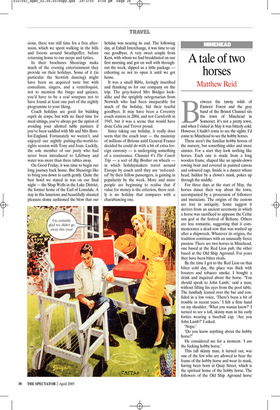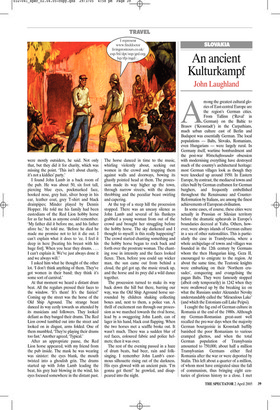A tale of two horses
Matthew Reid
Between the tawny wilds of Exmoor Forest and the grey band of the Bristol Channel sits the town of Minehead in Somerset. It’s not a pretty town, and when I visited in May it was bitterly cold. However, I hadn’t come to see the sights; I’d come to Minehead to see the hobby horses.
These aren’t the familiar hobby horses of the nursery, but something older and more sinister. For a start they look nothing like horses. Each one is made from a long wooden frame, shaped like an upside-down rowing boat and covered in painted canvas and coloured rags. Inside is a dancer whose head, hidden by a clown’s mask, pokes up through the middle.
For three days at the start of May, the horses dance their way about the town, accompanied by a procession of followers and musicians. The origins of the custom are lost in antiquity. Some suggest it derives from an ancient ceremony in which a horse was sacrificed to appease the Celtic sun god at the festival of Beltane. Others are less romantic, suggesting that it commemorates a dead cow that was washed up after a shipwreck. Whatever its origins, the tradition continues with an unusually fierce passion. There are two horses in Minehead, one based at the Red Lion pub, the other based at the Old Ship Aground. For years they have been bitter rivals.
By the time I got to the Red Lion on that bitter cold day, the place was thick with boozers and tobacco smoke. I bought a drink and inquired about the horse. ‘You should speak to John Lamb,’ said a man, without lifting his eyes from the pool table. The landlady leaned over the bar and confided in a low voice, ‘There’s been a bit of trouble in recent years.’ I felt a firm hand on my shoulder. ‘What you wanna know?’ I turned to see a tall, skinny man in his early forties wearing a baseball cap. ‘Are you John Lamb?’ I asked.
‘Nope.’ ‘Do you know anything about the hobby horse?’ He considered me for a moment. ‘I am the fucking hobby horse.’ This tall skinny man, it turned out, was one of the few who are allowed to bear the frame of the hobby horse and wear its mask, having been born in Quay Street, which is the spiritual home of the hobby horse. The followers of the Old Ship Aground horse were mostly outsiders, he said. Not only that, but they did it for charity, which was missing the point. ‘This isn’t about charity, it’s not a kiddies’ party.’ I found John Lamb in a back room of the pub. He was about 50, six foot tall, piercing blue eyes, pockmarked face, hooked nose, grey hair, silver hoop in his ear, leather coat, grey T-shirt and black drainpipes; Minder played by Dennis Hopper. He told me his family had been custodians of the Red Lion hobby horse for as far back as anyone could remember. ‘My father did it before me, and his father afore he,’ he told me. ‘Before he died he made me promise not to let it die out. I can’t explain what it does to ’ee. I feel it deep in here [beating his breast with his huge fist]. When you hear they drums.... I can’t explain it. We’ve just always done it and we always will.’ I asked him what he thought of the other lot. ‘I don’t think anything of them. They’ve got women in their band; they think it’s some sort of carnival.’ At that moment we heard a distant drum beat. All the regulars pressed their faces to the window. ‘It’s them! It’s the fairies!’ Coming up the street was the horse of the Old Ship Aground. The strange beast danced its way eerily towards us attended by its musicians and followers. They looked defiant as they banged their drums. The Red Lion crowd tumbled out into the street and looked on in disgust, arms folded. One of them mumbled, ‘They’re playing their drums too fast.’ Another agreed, ‘Typical.’ After an appropriate pause, the Red Lion horse appeared, with my friend from the pub inside. The mask he was wearing was sinister: the eyes blank, the mouth twisted into a ghoulish grin. The drums started up with John Lamb leading the beat, his grey hair blowing in the wind, his eyes focused somewhere in the distant past. The horse danced in time to the music, whirling violently about, seeking out women in the crowd and trapping them against walls and doorways, bowing its ghastly pointed head at them. The procession made its way higher up the town, through narrow streets, with the drums throbbing and the peculiar beast swirling and capering.
At the top of a steep hill the procession stopped. There was an uneasy silence as John Lamb and several of his flunkeys grabbed a young woman from out of the crowd and brought her struggling before the hobby horse. The sky darkened and I thought to myself: is this really happening? The crowd started chanting something and the hobby horse began to rock back and forth over the prostrate woman. The chanting rose in intensity and the faces looked fierce. Then, before you could say wicker man, the sun came out from behind a cloud, the girl got up, the music struck up, and the horse and its prey did a wild dance together.
The procession turned to make its way back down the hill but there, barring our way, was the Old Ship Aground horse surrounded by children shaking collecting boxes and, next to them, a police van. A thrill of excitement ran through our procession as we marched towards the rival horse, lead by a swaggering John Lamb, can of lager in his hand, black coat flapping. When the two horses met a scuffle broke out. It wasn’t much. There was a sudden blur of red faces, coloured fabric and police helmets; then it was over.
The rest of the evening passed in a haze of drum beats, bad beer, rain and folksinging. I remember John Lamb’s enormous silhouette rising out of the darkness. His eyes glowed with an ancient pain. ‘I’m gonna get them!’ he growled, and disappeared into the night.






























































 Previous page
Previous page